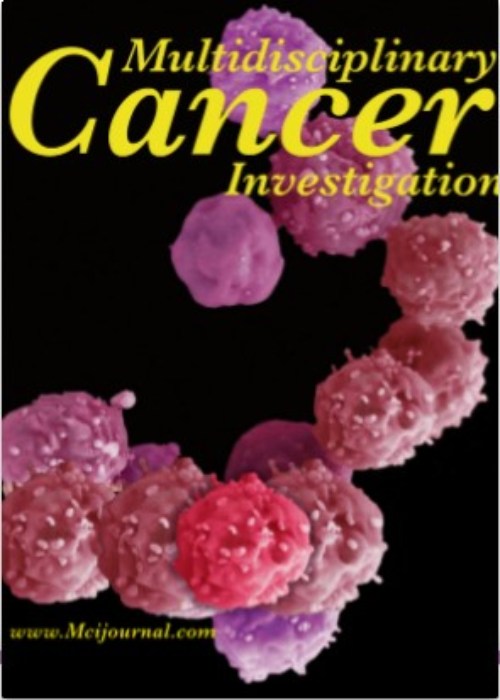فهرست مطالب

Multidisciplinary Cancer Investigation
Volume:7 Issue: 2, Apr 2023
- تاریخ انتشار: 1402/05/16
- تعداد عناوین: 3
-
-
Pages 1-12
3D nanoscale networks that are created with polymers physically or chemically are called Nanogels (NGs). Their biocompatibility, high stability, drug loading capacity, and ability to bind ligands for active targeting make them ideal for drug delivery systems. Moreover, they can respond to both internal and external stimuli, such as temperature, light, pH, and more. This makes it easier to consistently deliver the drug to the target area. Alginate (ALG) biopolymers are used for the encapsulation of anticancer drugs because of their biocompatibility, hydrophilicity, and affordability. These ALGs nanogel-based systems are effective in treating cancer, with several studies supporting their development. The ALG and its underlying systems are reviewed in this article.
Keywords: Alginates, Gels, Drug Delivery, Cancer, Stimuli-Responsive -
Pages 13-18Introduction
The study attempted to investigate the contribution of elastography in the diagnosis and assessment of the extent of Invasive Lobular Carcinomas (ILCs) compared to Invasive Carcinomas of no Special Type (ICNST).
MethodsThe current retrospective study included 85 female patients (mean age: 55 years) with invasive breast carcinoma. Ultrasound B mode and strain elastography were performed for each mass. Qualitative criteria (elasticity score) and quantitative criteria (strain and length ratio) of elastography were studied. Histopathological examination was considered the gold standard for final diagnosis.
ResultsOf 85 invasive carcinomas, there were 30 ILCs and 55 ICNST. The strain ratio of ILCs was higher than ICNST (P<0.05). The mean length ratio of ILCs was significantly higher than ICNST (P<0.0001). The lesions were mostly scored 5 in both histological types without significant difference (P=0.13).
ConclusionInvasive lobular carcinoma poses a problem in detecting and extending lesions to conventional imaging. Breast ultrasound elastography can help diagnose and evaluation of the extent of invasive lobular carcinoma.
Keywords: Breast, Elastography, Ultrasound, Mass, Lobular Carcinoma -
Pages 19-29Introduction
This study aimed to investigate the effectiveness of the Unified Protocol for Transdiagnostic Treatment of Emotional Disorders (UP) for women with breast cancer.
MethodsIt was a pilot randomized controlled trial in which women with breast cancer were allocated to a 9-week Unified Protocol for transdiagnostic treatment of emotional disorders (UP) (n=14) or a wait-list control group (n=15). Pre-and post-intervention, the Beck Depression Scale (BDI-II), Beck Anxiety Scale (BAI), Depression, Anxiety and Stress Scale (DASS-21), Cognitive Flexibility Inventory, Cognitive Emotion Regulation Strategies Scale (CERQ), Emotional Awareness Level Scale (LEAS), and The EORTC Breast Cancer-Specific Quality of Life (EORTC QLQ-BR23) were completed.
ResultsSignificant reductions in depressive, anxiety, and stress symptoms, as well as maladaptive emotional regulation strategies, were observed within the UP from baseline to post-treatment. Compared to the waitlist-control condition, participants in the UP condition showed increased adaptive strategies of emotional regulation, cognitive flexibility, mindful emotional awareness, and quality of life.
ConclusionsThe findings provide preliminary evidence for the utility of the UP in the reduction of psychological dysfunctions and improving the quality of life in women with breast cancer.
Keywords: Protocol for Transdiagnostic Treatment of Emotional Disorders, Flexibility, Mindfulness, Emotional Regulation, Quality of Life, Breast Cancer

